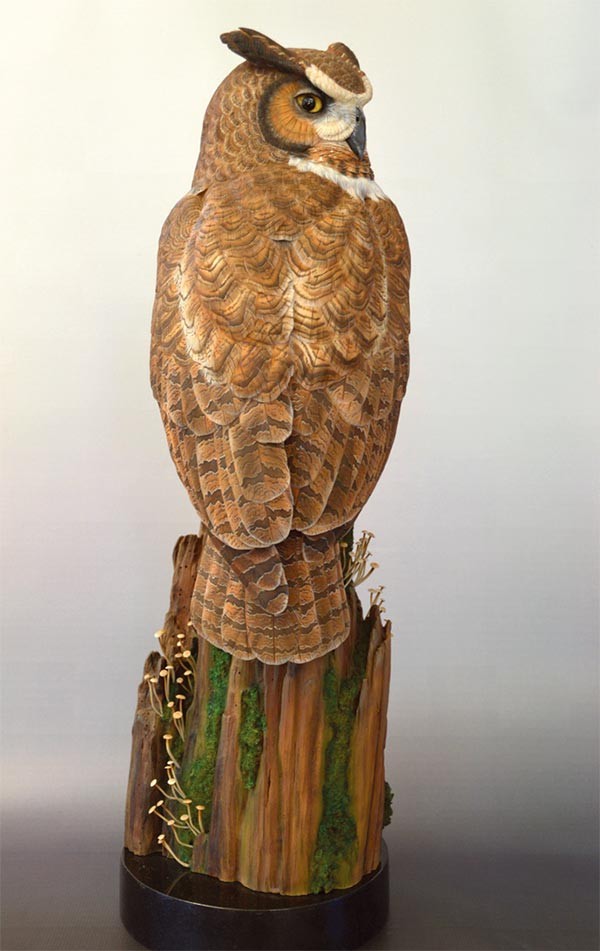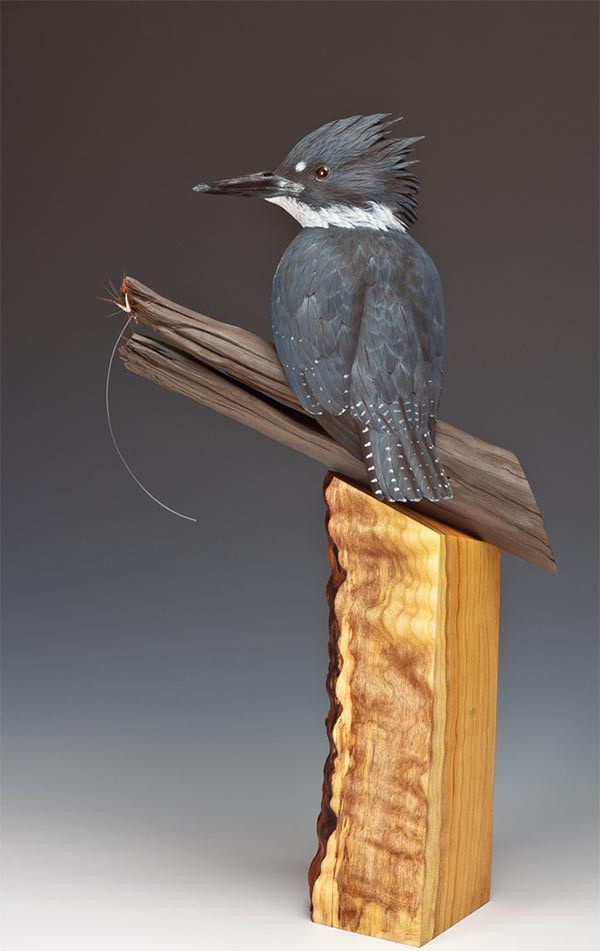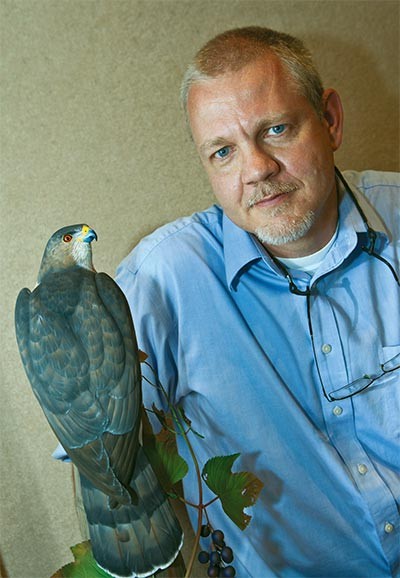
Before Al Jordan was the preeminent bird carver in the Northeast; before his carvings were worth thousands of dollars and he’d won top prizes at the most prestigious wildlife art exhibits, there was just a boy, and his brother, and his dad watching birds on a picture-book autumn day.
“We’d sit on lookouts and watch hawks fly by,” he recalled. “What hooked me was when my brother and I were playing on the boulders at Hawk Mountain in Pennsylvania while my dad was counting birds, and a pair of golden eagles soared 20 feet above us. We just sat there as they watched us. Those birds could have easily dropped down and carried us away.”
He’s been attracted to raptors ever since.
As a young man, Jordan spent 15 years as a volunteer at a bird banding station along the shores of Lake Ontario, helping to capture and place identification bands around the legs of hundreds of hawks, falcons, and eagles.
“I’m a raptor guy,” he said of his favorite birds. “They’re at the top of the food chain, the boss, the king; they’re powerful, majestic, mighty. But they’re still very fragile animals.”
Jordan pursued a culinary career and worked as an executive chef at private country clubs for 25 years. In his off hours, to relieve stress, he carved wood. He carved his first bird when a friend commissioned a bufflehead decoy – a black-and-white diving duck. That carving went on to win every competition in which it was entered. It also set him on a new path in life, one that allowed him to eventually quit his day job and devote himself full-time to bird carving.
For Jordan and most other professional bird carvers, the days of using a sharp knife and sandpaper to create life-like birds are ancient history. Today, almost everyone uses high-tech power tools with diamond bits that Jordan says remind him of the equipment used in a dentist’s office. He carved that first bufflehead decoy with one knife, but almost every bird he’s worked on since then has been carved with power tools.
His wood of choice is black gum tupelo, a southern species he obtains from a favorite vendor in Louisiana, where he says the best tupelo comes from.
“It’s a very soft wood, softer than pine, but it’s also very strong,” Jordan said. “It grows so slowly that its grain is very close together, which is what makes it strong. And it lends itself to power tool carving.”
He typically purchases a truckload of tupelo at a time, enough to last for several years, and he selects particular pieces that appeal to him. “I want the grain to be very close; I want the wood to be light weight; and when looking at it from the end, I want little or no curvature in the grain,” he said. “I want the grain to run straight through the wood, which makes it stronger and easier to carve.”
He collects other wood, as well – especially maple burls and cherry, both of which he uses as the bases of his carvings and for other elements in his compositions.
Although he describes himself as a bird carver, Jordan said that every project involves three very different art forms: the creative composition and design, including tree branches, leaves, and what the bird will be mounted on; the wood carving and sculpting; and the painting of the finished carving, a skill he learned as a child from painting his father’s collection of miniature metal soldiers.
Jordan begins the carving process by sketching the profile of the bird on one side and the overhead view of the bird on the top of a square block of wood. He then uses a band saw to roughly cut the shape. “At that point you basically have a square bird, but if you can see into the wood you can see where you’re going,” he said. “From there it’s a matter of rounding the corners to turn it into a three-dimensional object.”
The length of time required to complete a carving depends on both the size and detail desired in the finished product. If it’s going to be what Jordan calls a “slick” – a smooth figure without individual feathers carved – he can usually carve and paint it in about three days. “But to do the same bird in the same pose and have it highly decorated with every feather carved and all the details, that could take me two months,” he said.
This past winter and spring Jordan focused on the completion of a life-sized, short-eared owl that he entered into the Ward World Carving Championships. It placed third best in show in the master division, but took first place at several other competitions. Rarely, though, does he get this opportunity to carve something of his choice, as most of his work is done on commission or as part of carving classes he teaches.
He spends about half of his time teaching – either week-long classes of up to a dozen people or one-on one sessions that can last as long as two weeks. He typically polls the class members to determine what species they want to carve, and he carves the same bird right alongside them in order to demonstrate each step of the process.
One of his most popular carving classes takes place annually in Lake Placid, New York, and 80 percent of the students return year after year. Recent class carving projects have included carving a miniature great horned owl and a life-sized merlin. Jordan also regularly instructs a group from Canada that visits his studio for two days every month. They’re currently working on a screech owl. He is also finishing a red tailed hawk, which is the basis of a book he is writing about bird carving.
In addition to his work in the classroom and in his studio in Rochester, New York, Jordan frequently serves as a judge at carving competitions and exhibits his work at shows around the Northeast, all of which builds word of-mouth about his artwork and helps to market his carvings.
Years of carving and banding birds has yet to satisfy his interest in raptors, so Jordan has also become a master falconer. He owns three hawks that he takes out to fly and hunt every day during the falconry season. He says the intimate relationship he has developed with his birds is complicated. “For the bird, the relationship is all about food. They don’t care about you or love you or miss you. But I view it like any other pet owner, even though they’re not pets. I have a strong bond with them, and the feeling I get when they’re in action in the wild is really unbelievable.”
Although Jordan said that his time banding hawks along Lake Ontario helped to learn about bird anatomy, which improved his carvings, he admits that his falconry has played an even greater role.
“My carving is vastly improved since I became a falconer, mostly because I have birds in hand constantly and I can pick up nuances within feather groups and I can translate that to my carvings, even when I’m not carving raptors,” he said. “But, ultimately, my passion is for all things birds – carving them, looking at films of them, painting them, it doesn’t matter. I have a passion for the animal.”
More of Al Jordan’s carvings can be seen online here.



